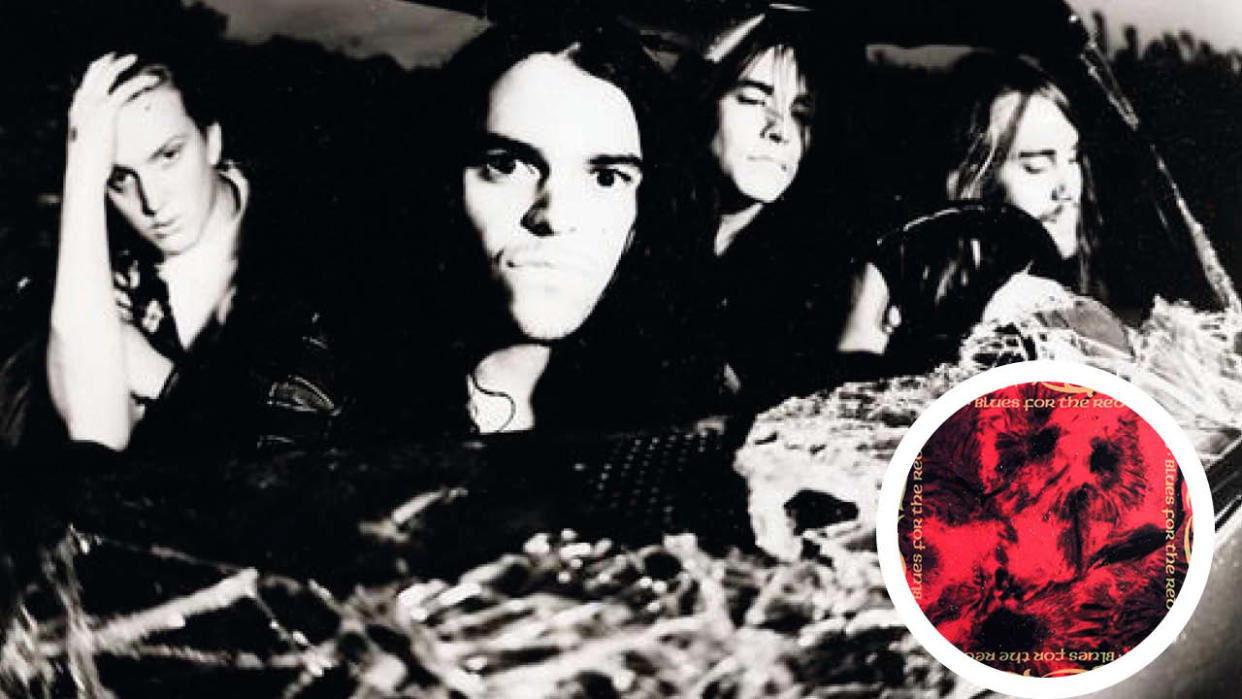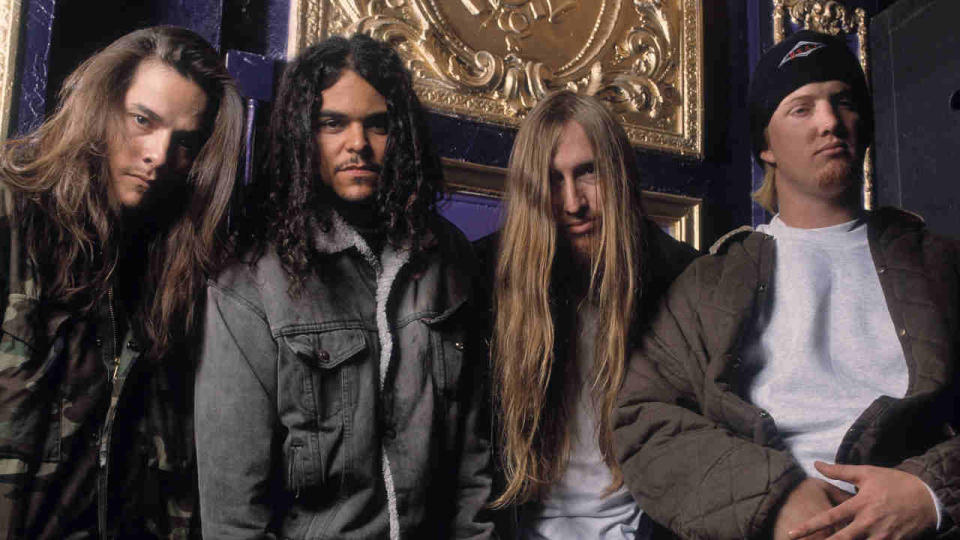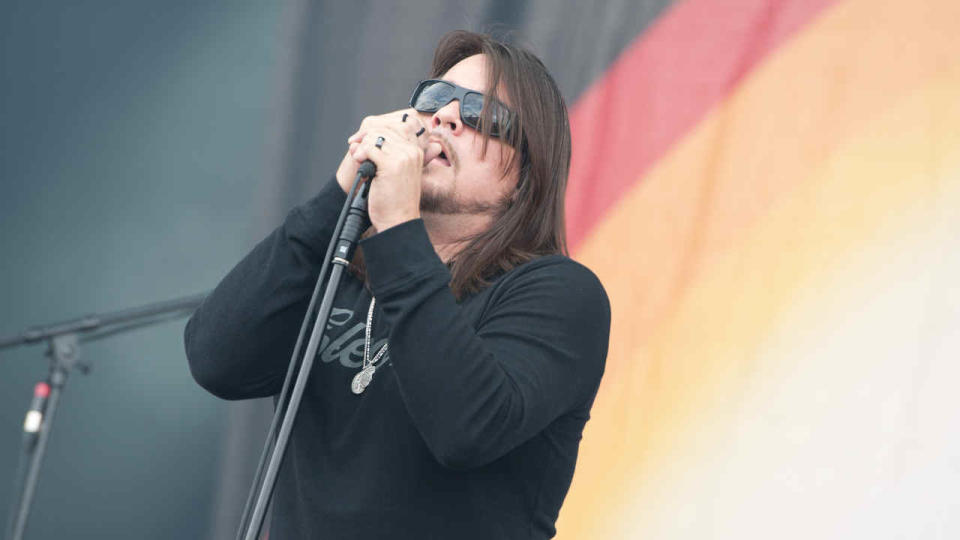Kyuss’ Blues For The Red Sun: the inside story of a stoner metal landmark

A band whose brief seven-year existence has enabled them to remain enigmatic and shrouded in hazy folklore, Kyuss were a classic example of musicians who assimilated the ambience and vibe of their surroundings and spewed it back out as something genuinely but unintentionally original and groundbreaking.
Formed in Palm Desert, California, in 1988, first as Katzenjammer and then Sons Of Kyuss, they were inspired by everything from punk to Black Sabbath, eventually settling on a sound that could hardly have better suited their sun-ravaged, sand-blasted environment. Their evolution has been repeatedly mythologised since their split in 1995, but Kyuss really did develop their chops by taking a petrol-powered generator out into the desert and throwing rock’n’roll keg parties for their slacker buddies and anyone else who showed the slightest interest in their thunderous, freewheeling take on heavy music.
However, despite releasing their debut Sons Of Kyuss EP in 1990 and the full- length Wretch one year later, Kyuss had still not refined or defined the sound that would eventually make them legends.
“When we were practising up in Brant Bjork’s bedroom, I don’t think we set out to change the face of rock’n’roll or change or start some new genre at all,” states vocalist John Garcia. “I personally don’t think that we did! But when you hear Blues For The Red Sun, there’s something special going on. It’s crazy. You have Brant Bjork on drums, Nick Oliveri on bass, Josh Homme on guitar and myself, all in the same room. Somebody asked me recently ‘What’s your idea of a supergroup?’ and I’ll tell you, I’ve been in that supergroup! I remember Brant sitting me down on his bed saying, ‘Hey, I’ve written this song called Green Machine!’ and then playing it for me. He goes, ‘You’re gonna sing it like this!’ and that was how it came about. I’m extremely lucky to have worked with Brant and Josh. I put those two guys on a very high pedestal. I love them dearly.”
Arguably the key relationship in the evolution of Kyuss from suburban hopefuls to one of the most revered rock bands on the planet was their working partnership with producer Chris Goss. Best known for his own band, Masters Of Reality, who had already successfully blended the heaviness of Sabbath with a strong and idiosyncratic strain of psychedelia, Chris was a man with an intuitive grasp of what great rock’n’roll should sound like, and when he stumbled across the band performing in a dingy LA dive one night, he immediately recognised that he wanted to be part of the Kyuss story and to facilitate the birth of an album worthy of their prodigious talents.

“I think Chris believed in us,” says John. “He saw something that he may not have seen in bands before. It was this untapped, unfucked-with thing that Hollywood hadn’t tainted yet. LA hadn’t ruined it yet. We were in our own little bubble, out here in the desert, and he saw that we had some potential. We were very familiar with Masters Of Reality (the self-titled debut album by Chris’s band) and listening to The Blue Garden, it blew us away. He was a super guy and there was automatic trust. He was willing to use his talents to help us to bloom into our own. Chris Goss is extremely talented and he’s a great producer and I love him dearly.”
Recorded at Sound City in Van Nuys, California, Blues For The Red Sun comprised the bulk of the material that Kyuss had been honing during rehearsals and at those notorious generator parties. With Chris handling production duties and a young Joe Barresi acting as engineer, the recording sessions were swift and productive, resulting in an album that sounds like an untamed and mercurial jam session captured on tape. Tracks like the rambling but powerful 50 Million Year Trip (Downside Up) and Freedom Run represented a sizzling collision between punk rock energy and the drug-addled, limit-free explorations of space rock. Combined with the throbbing bottom end of Chris’s production, which was greatly enhanced by Josh’s widely reported insistence on playing his guitar through a bass amplifier, the album sounded utterly unique.
“That was part of Kyuss. We did jam. You might even hear a couple of fuck-ups in there!” laughs John. “That’s what we did! We ran through the takes live, and the majority of it was live, and I came back in and cut the vocals. To my best recollection there were some jams. Obviously, songs like Apothecaries’ Weight, Caterpillar March and Molten Universe, those instrumental pieces were definitely recorded that way and that’s just the way we wanted to do it, to capture that live sound as much as possible. That’s when bands really shine, so we wanted to capture that really well and I think Chris did a great job, an amazing job, and it is what it is!”
In stark contrast to the somewhat stilted sonic range and na?ve songwriting of Wretch, Blues For The Red Sun sounds like the work of a band who knew exactly what they were doing. Their demeanour might have suggested that Kyuss were spending more time squinting down a bong pipe than focusing on their creative skills, but the reality was entirely different. For all its fuzziness, Blues For The Red Sun was ferocious and intense.
“We were four very young guys with a lot of angst and that angst came out in that record,” explains John. “I think we just continued to grow. It was always a growing process and I’m proud to have been part of it. I was becoming a better vocalist just as Josh was becoming a better guitar player. We were kids, getting older and maturing and finding out what was going on in our lives and in our stories. Pure angst on vinyl! When you talk about those songs, you need to talk about Brant and Josh. They really were the masterminds behind Blues for The Red Sun. Being a fly on the wall and seeing Brant and Josh in the same room together and seeing that magic and then me, coming in and putting my stamp on things, it was an incredible thing to be involved with. I’m a modest person but I’m also a straight shooter and I’ve got to give credit where credit is due, and a lot of that, the majority of that credit, goes to Brant and Josh.”
Released in 1992 on underground label Dali Records, Blues For The Red Sun was never likely to be a huge seller, but it received reviews that most bands would donate an internal organ to pick up. In some ways it arrived at a perfect time, providing a heavier and palpably less morose alternative to Nirvana’s ragged but glossy Nevermind while simultaneously delighting fans of bands like Black Flag, Saint Vitus and Monster Magnet with an invigorating dose of trippy but crushing hard rock. True to their somewhat lackadaisical, suck-it-and-see approach to their career, Kyuss themselves were largely unaware that they were becoming a cool name to drop in rock circles.
“We had no idea!” chuckles John. “We knew that the band didn’t want to suck. I don’t think Blues… is a record that sucks. Either you like it or you don’t and a review is just one opinion, one perspective on it. I’ve collected just about everything that was written on it and I’d say about 75 per cent of the reviews were positive and that was really good for us, but we didn’t think about it too much at the time.”
An impressive critical hit, Blues For The Red Sun didn’t sell in vast amounts and was a slow-burning success, building momentum as praise for the album was spread by word of mouth, but within time it became clear that a new subgenre was evolving, primarily inspired by Kyuss’s sound. Just as Cathedral had revitalised interest in the slow riffs and post-Sabbath grooves of doom in the UK, so Kyuss were involuntarily instrumental in the birth of what would become widely known as stoner rock. Typically, John refuses to take any credit for what was happening.
“I didn’t know about any of that until after the band had broken up!” he says. “That is par for the course with bands like us, man. Once the band breaks up, suddenly everyone runs out and buys all their stuff because it’s over. We’re getting all this hoopla now, like, ‘Kyuss were awesome!’ and ‘Kyuss did this first!’ and I’m like, ‘Where the fuck were all these people when we were around?’”
Kyuss released two more albums, 1994’s Welcome To Sky Valley (featuring new bassist Scott Reeder) and 1995’s …And The Circus Leaves Town (with drummer Alfredo Hernandez taking the departed Brant Bjork’s place).

Sadly, the band split within a year of the latter’s release. Josh Homme joined grunge band Screaming Trees as a touring guitarist before founding Queens Of The Stone Age (initially featuring former Kyuss bassist Nick Oliveri), Brant went on to form Brant Bjork & The Bros and play with Fu Manchu, while John Garcia has fronted a number of bands, including Slo Burn, Unida and Hermano, as well as releasing a string of solo albums in recent years. A full-blown Kyuss reunion has never happened, though John, Brant and Nick Oliveri reunited in 2010 as Kyuss Lives!, before changing their name to Vista Chino and releasing an album, Peace, in 2013.
Today, Blues For The Red Sun is is considered a stoner rock cornerstone, though the band have all been eager to distance themselves from any responsibility for the spawning of that genre. It may not have sold massive amounts, but it’s influence remains huge.
“The success was not the main goal for us when we made Blues…,” says John. “It was about character and integrity and making ourselves happy. There was some- thing missing in our lives musically and we had to fill that void. Blues… filled that void and it filled it very well. The little bit of success that we tasted during that time, it was frowned on. We didn’t embrace it; we were afraid of it. We didn’t want to be superstars. We wanted to be an underground punk rock’n’roll band with our own sound; we wanted to be originators. I don’t think we thought it was cool to become super-huge. We’d have thought we were selling ourselves out! We wanted to stay grounded and level-headed, to make music for the people.”
Originally published in Metal Hammer issue 209
